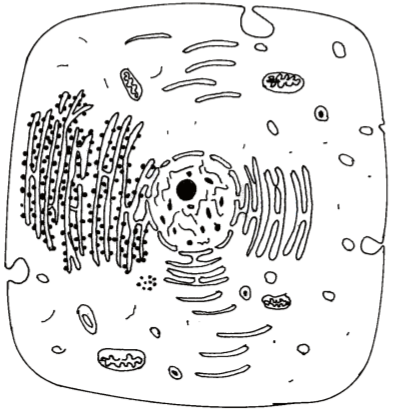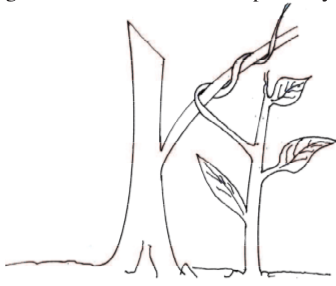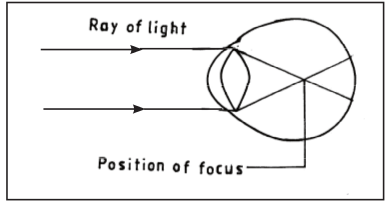BIOLOGY PAPER 1
-
- What is meant by the term wilting? (1 mark)
- Explain how an increase in temperature affects the rate of active transport. (2 marks)
- The diagram below represents a cell as seen under an electron microscope.

- Based on the diagram, state whether it represents an animal cell or a plant cell. (1 mark)
- Give two reasons for your answer in 2(a) above. (2 marks)
- Why is the palisade layer a tissue? (1 mark)
-
- State two external features found in the clas Mammalia only. (2 marks)
- Name the taxonomic unit that comes immediately after a phylum in classification. (1 mark)
-
- State two roles of mucus in the stomach. (2 marks)
- Explain how age determines a person's energy requirements (2 marks)
- Describe how turgor pressure builds up (3 marks)
- Using a microscope, a student counted 55 cells across a field of view whose diameter was 6000μm. Calculate the average length of the cells. Show your working. (2 marks)
- Explain how the following forces contribute to the movement of water up the xylem vessels: (2 marks)
- cohesion;
- adhesion.
- Construct a step in a dichotomous key using two leaves one with a serrated and the other with a smooth margin. (2 marks)
- State one way in which each of the following is structurally adapted to its function:
- neurone; (2 marks)
- mitochondrion (2 marks)
- How are lenticels adapted for gaseous exchange? (2 marks)
- State the advantage of possessing blood group AB. (1 mark)
-
- A student collected an organism and observed the following features: simple eyes, four pair of legs and two body parts.
- State the class to which the organism belongs. (1 mark)
- Give an example of an organism in this class. (1 mark)
- Name the kingdom to which plasmodium belongs. (1 mark)
- A student collected an organism and observed the following features: simple eyes, four pair of legs and two body parts.
- State two characteristics of living organisms that are specific to plants. (2 marks)
- Name the three end products of anaerobic respiration in plants. (3 marks)
- State two reasons why accumulation of lactic acid leads to an increase in heart beat. (2 marks)
- Name three mechanisms that ensure cross pollination takes place in flowering plants. (3 marks)
- Name the flower part that produces gametes. (1 mark)
- How is the human sperm cell structurally specialised? (2 marks)
- State three factors in seeds that cause dormancy. (3 marks)
- Explain the theory of evolution by natural selection. (2 marks)
-
- Explain the role of continental drift in evolution (3 marks)
- What is meant by the term organic evolution?
- The diagram below illustrates a response by a certain plant.

- Name the type of response (1 mark)
- Explain how the response illustrated above occurs (3 marks)
- The diagram below illustrates a defect in the eye

Explain how the defect illustrated above can be corrected. (2 marks) - Explain three protective functions of mammalian blood. (3 marks)
- State one adaptation of xylem vessels to their function. (2 marks)
-
- What is meant by the term sex linked genes? (1 mark)
- Name two sex linked traits in human beings. (2 marks)
-
- State two differences between complete and incomplete metarmorphosis. (2 marks)
- State the importance of moulting to an insect. (1 mark)
-
- State two features of a ball and socket joint (2 marks)
- Name the bone that allows the head to:
- nod; ...................................
- turn side ways ................................... (2 marks)
- State two functions of pelvic girdle in mammals. (2 marks)
- State two ways in which osmosis is significant to plants (2 marks)

MARKING SCHEME
-
- Is when the rate of water loss is more than the rate of absorption and the plant droops; (1 mark)
- The rate of active transport increases with increase intemperature up to the optimum temperature; 1 mark
Further increase in temperature slows down the rate of active transport until it stops because it denatures enzymes; 1 mark
-
- Animal cell; 1 mark
-
- Has cell membrane only/has no cell wall;
- Has numerous small vacuoles;
- Has central nucleus; Max. 2 marks
- Consists of many similar cells performing the same function; 1 mark
-
- Have mammary glands; have external ears/pinna;
Body covered with fur/hair; Max. 2 marks - Class; 1 mark
- Have mammary glands; have external ears/pinna;
-
- Lubrication; Protection; 2 marks
- Young people are more active; requiring more energy;/
Older people are less active; requiring less energy; 2 marks
- As the cell gains water by osmosis; the sap/cellvacuole enlarges; pushing the cytoplasm outwards; exerting pressure on the cell wall; Any 3 (3 marks)
- 6000(μm)
55 (cells) ; 109μm; 2 marks -
- Water molecules cling to each other maintaining a continuous column of water/preventing the break of water column; 1 mark
- Water molecules cling to the sides of the xylem vessel walls; 1 mark
-
- Leaf with serrated margin -- go to 2;
- Leaf with smooth margin -- go to --; 2 marks
-
- Presence of myelin sheath for insulation/increases transmission; Axon for transmission of impulses;
Large cell body controls activites of cell; Nerve endings/dendrites receives impulses from receptors cells;
Node of Ranvier speeds up impulse transmission. - Inner membrane highly folded/cristae to increase S A for attachment of (respiratory) enzymes. 4 marks
- Presence of myelin sheath for insulation/increases transmission; Axon for transmission of impulses;
- Cells loosely arranged; to facilitate air circulation;
Cells have moist surfaces; to dissolve respiratory gases; 2 marks - Can receive blood from any donor/ universal recepient; 1 mark
-
-
- Arachnida; 1 mark
- Spider/scorpion/tick/mite; 1 mark
- Protoctista/protista; 1 mark
-
- Autotrophic nutrition; show alternation of generation;
Limited movement;
Limited excretory products/unspecialized respiratory structures;
Localised growth; 2 marks - Alcohol/ethanol; Carbon (IV) oxide; Energy/Adenosine Triphosphate; 3 marks
-
- To increase supply of oxygen to the tissues;
- The oxygen is used to oxidize lactic acid (to carbon (IV) oxide, water and energy); 2 marks
- Protogyny; protandry; Dioecious; Dichogamy;
Self sterility/incompatibility; Heterostyly;
Presence of structures/substances to attract agents of pollination; Max. 3 marks - Ovary /Anther; 1 mark
-
- Acrosome/Lysosome contain enzyme to digest membrane of the ovum;
- Numerous mitochondria to provide energy for movement;
- Long tail for faster movement; Max. 2 marks
-
- Embryo not fully developed;
- Chemical inhibitors/presence of abscisic acid;
- Hard/impermeable testa/seed coat;
- Low hormones/low enzymes concentration; Max. 3 marks
- Genetically acquired beneficial characteristics which occur spontaneously; are perpetuated through reproduction; 2 marks
-
- Continents existed as one large Landmass/Pangea/Laurasian and Gondwana Land;
Present continents drifted from it leading to isolation of organisms; organisms in each continent evolved along different lines hence emergence of new species; 3 marks - Emergence of new life/species/organisms from preexisting simple forms, gradually over a long period of time, to present complex forms; 1 mark
- Continents existed as one large Landmass/Pangea/Laurasian and Gondwana Land;
-
- Thigmotropism/Haptotropism; 1 mark
- Part of the tendril in contact with support causes migration of auxins to the opposite side;
leading to faster cell division/growth on the side not in contact with the support;
This causes the tendril to curl around the support; 3 marks
- Use of biconcave/concave lens/divergent lens; to diverge the rays and make image be focussed on the retina; 2 marks
-
- Contains antibodies that defend the body from foreign antigens;
- Has white blood cells that produce antibodies/while blood cells engulf antigens;
- Has platelets that initiate blood clotting to prevent excessive bleeding at an open wound/ prevent entry of pathogens; 3 marks
-
- Thin and long to allow for capillarity;
- Walls lignified to strengthen the stem/to prevent collapse of vessels;
- Have bordered pits to allow for exchange of materials; Max. 2 marks
-
- Genes inherited along with the sex chromosomes; 1 mark
- Haemophilia; hairy ears/pinna/nose; colour blindness/red green; blue-green colour blindness;
Muscular diastrophy; baldness 2 marks
-
- Complete metamorphosis - eggs hatch into larvae while in incomplete metamorphosis hatch into nymphs which resemble the adult;
Complete metamorphosis has four stages; egg, larvae, pupa and adult while an incomplete metamorphosis has three stages; egg,nymph and adult. 2 marks - To allow for growth of the insect; 1 mark
- Complete metamorphosis - eggs hatch into larvae while in incomplete metamorphosis hatch into nymphs which resemble the adult;
-
- Ligaments; synovial fluid; synovial membrane; articular cartilage;
synovial capsule; a bone with rounded head fitting into a cavity of another bone; Max. 2 marks - (i)Atlas; (ii) Axis allows movement in all planes; 2 marks
- Ligaments; synovial fluid; synovial membrane; articular cartilage;
-
- Form joints with the legs to make walking possible; 1 mark
- Provide large surface area for attachment of muscles; 1 mark
- Offers support (to the body weight)
- Absorption of water; support;
Opening and closing of stomata;
Feeding in insectivorous/plants;
Download Kenya Certificate Of Secondary Education(KCSE 2013) Biology Paper 1 with Marking Scheme.
Tap Here to Download for 50/-
Get on WhatsApp for 50/-
Why download?
- ✔ To read offline at any time.
- ✔ To Print at your convenience
- ✔ Share Easily with Friends / Students

